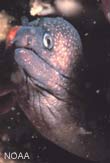An Amazing First: Two Species Cooperate to Hunt

The giant moray eel is normally a lone hunter in the dark. Now scientists find these eels may at times hunt in the daytime in the Red Sea, and surprisingly cooperate with another predatory fish, the grouper, which is also normally a solitary predator.
This is the first example of coordinated hunting seen in fish, and the first known instance of cooperative hunting between species seen outside humans, researchers said.
The giant moray eel is as thick as a man's thigh and can grow up to nearly 10 feet long. It normally lurks through crevices in coral reefs at night to corner victims in their holes, meaning the best way to avoid these hunters is to swim into open water. On the other hand, groupers normally hunt in the open water during the day, meaning the best way to avoid them is to hide in coral reefs.
Behavioral ecologist Redouan Bshary from the University of Neuchâtel in Switzerland was following groupers to collect information on so-called "cleaner fish" that enter the mouth of predators to eat parasites.
"When I first saw a grouper shaking its head in the face of a moray, I thought two top predators were about to fight each other," Bshary said. "So I was very surprised when they swam off together side by side."
Bshary and his colleagues followed fish around by snorkeling. They found groupers often visited giant morays resting in their crevices and rapidly shook their heads an inch or so from the eels to recruit them in a joint hunt. At times this call took place after a grouper failed in its hunt because prey escaped into a crevice the grouper could not get into but a giant moray might.
If the moray emerged, the grouper guided the eel to a crevice where prey was hiding. Groupers sometimes even performed a headstand and shook its head over a prey hiding place to attract moray eels to the site. At times the moray ate the fish it rooted out, while at other times the grouper did. [Video]
Get the world’s most fascinating discoveries delivered straight to your inbox.
Before this, coordinated hunting was only seen in mammals and birds. In addition, until now the only other examples of cooperative hunting between species were seen with humans and dogs or humans and dolphins, Bshary said.
The researchers are uncertain whether this cooperation is an innate or learned behavior, although currently Bshary suspects it is learned because there is considerable variation in levels of it between individuals, especially in morays, "which may reflect personal experience." They plan to study whether this cooperation is local to the area they studied or whether it is widespread in the Red Sea.
"The most important implication is that there are still so many surprises to be discovered in coral reefs," Bshary said.
Bshary and his colleagues reported their findings in the December issue of the journal Public Library of Science Biology.
- Images: Freaky Fish
- Amazing Animal Abilities
- Tiny Fish Learn to Sniff Out Predators
- A No Brainer: Predators Prefer Dimwitted Prey
- Top 10 Deadliest Animals
- All About Fish

 Live Science Plus
Live Science Plus





